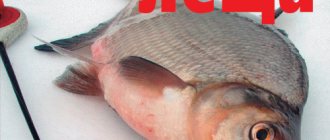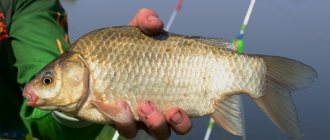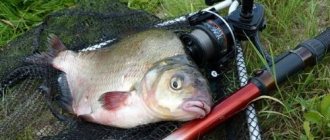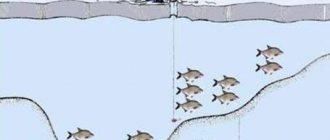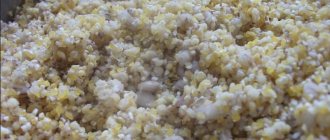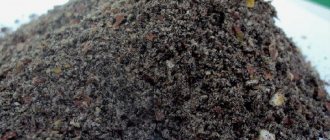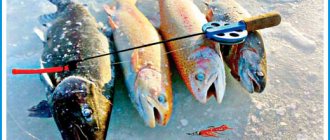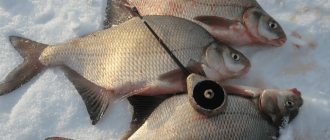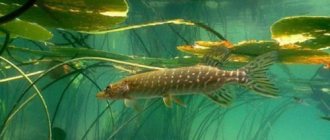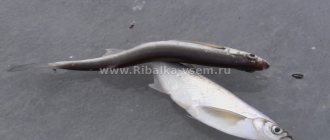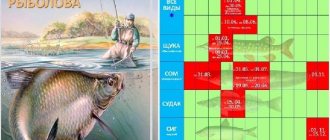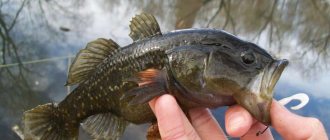Bream is one of the most anticipated trophies for fans of feeder fishing and other numerous types of fishing. However, in order to catch a truly large fish, it is necessary to take into account many important factors: features of the fishing location, time, attachments or bait, choice of bait, equipment of gear. Even for a fisherman who is not a highly professional fisherman, feeder gear turns into an effective fishing tool that allows you to experience the fight with very large fish and never be left without a catch in the hot summer month.
Peculiarities of bream behavior in July
Summer heat negatively affects the behavior of absolutely all types of fish in various bodies of water. During the daytime, their rhythm freezes, with rare exceptions, all activity is transferred to the night and morning, which determines the popularity of night fishing.
In July, small individuals of bream - bream - roam throughout the reservoir in small flocks, actively feed, do not go to the deep places of the river, reservoir or lake, staying close to the coastline and coastal vegetation. Large bream lead a completely different lifestyle, sticking to the deepest places during the day. Although there are exceptions to every rule.
July bream is indeed slightly unpredictable, and those who say that catching bream in the middle of summer is very easy are not entirely right. Rather, they are talking about catching bream, but in order to hunt for a truly trophy bream, the angler will have to take preparation very seriously: choosing a place for fishing, composition of groundbait, bait. The behavior of bream always depends on the conditions of the specific reservoirs in which this fish lives: depth, bottom topography, temperature conditions. It is these features that we will talk about.
Features of bream tackle
If you want to catch bream on a feeder in the summer, you need to pay attention to the gear.
- The length of the rod should be about 3.30-4 meters. Its test depends on the weight of the feeder filled with food. On rivers it is somewhere around 70-140 grams, the average test is 90 grams.
- It is important that the feeder holds the bottom very well. When fishing on lakes and reservoirs, feeders can be placed smaller, since the need to hold it in the current disappears. Feeders for fishing on the river: triangular, rectangular, closed type is better when using fine-grained bait. When using large fractions - open. They are more stable in the current. For fishing on the lake, you can use various forms of feeders, regardless of their weight.
- The reel for the feeder is selected 2500-3000 units with a metal spool; the clutch must be working, no matter whether it is rear or front. A baitrunner will most likely not be useful for such fishing, but you shouldn’t write it off right away - anything can happen.
- You need to choose a fishing line or braid that is as strong as possible and at the same time thin. For the main fishing line, it is better to take a 0.12 cord, a leash - a 0.14 mm monofilament. This balance is due to the caution of bream in summer. At the end of the braid, it is necessary to use a shock leader (0.26-0.27 mm) made of fluorocarbon.
- Hooks must be durable and of very high quality. Numbers 9-14 will do. The size of the hook directly depends on the type of bait. The best hooks are now considered to be products from the Ovner company.
- The feeder must be equipped with at least three replaceable tips, adapted for the use of feeders of different weights, for places with different flow intensities.
When fishing for bream, all main types of installation of feeder equipment are suitable. The most commonly used are paternoster and asymmetrical loop.
Bream fishing gear
If we talk about fishing gear used when catching bream in July, then a lot depends on the conditions and time of fishing. This can be either a regular float rod or a fisherman’s favorite feeder, equipped with a feeder. Experienced fishermen prefer to have several types of gear in stock at once, for example, a spinning rod, a donkey and a float rod. In addition, it makes sense to take care of a variety of baits for fish, as well as baits and lures that provide a bite.
Read the description of sea bream.
Feeder
One of the most popular fishing gear among specialists is the English bottom fishing rod - feeder. It is convenient because the feeder mounted to it allows you to deliver complementary food to the bottom of the selected place without washing out. A tempting cloud of bait forms in the right place and can attract a large number of fish. For summer fishing, it is better to get a feeder with a rod length of 3–3.5 m.
This is the optimal length for easy fishing from the shore. When choosing a feeder mounted to the bottom, it is better to opt for a specimen whose weight is approximately 120 g. Such a feeder will easily and reliably be installed on the flat bottom of the reservoir. The correct equipment of the feeder, designed for the conditions of a particular reservoir, is also important. Thus, in rivers with strong currents, the following types of equipment should be used:
- helicopter;
- asymmetrical loop.
Find out the difference between bream and silver bream.
In reservoirs with standing water or weak currents the following have proven themselves to be effective:
- symmetrical loop;
- paternoster;
- harvester
As for the hooks, they must match the specific type of bait or attachment. For the most part, fishermen choose specimens No. 9–14.
Video: lessons on catching bream on a feeder
Float rod
Bream bites well in summer even on ordinary float gear. For daytime fishing from a boat, fishermen use a float rod with a long rod and thin equipment. For fishing from the shore, a Bolognese fishing rod is suitable, suitable for any body of water. Previously, such fishing tackle was considered a rather heavy fishing tool, but in recent years, manufacturers have begun to make fishing rods from ultra-light materials.
Important! When going fishing, you need to monitor the atmospheric pressure for several days. With sudden changes in the barometer, you can’t count on a good catch.
Such a fishing rod can be equipped with various floats, which should be selected based on fishing conditions:
- In shallow water, a float with low resistance has proven itself well. For example, in the form of a shortened feather.
- For fishing in calm weather, a feather-shaped float with high sensitivity would be an excellent choice.
- In light winds, it is better to use a barrel, which will lie on its side at the slightest bite.
If we talk about the width of the fishing line used for catching bream, then you don’t have to worry too much here, since well-fed fish pay little attention to the fishing line. Thus, the optimal option is considered to be a durable monofilament measuring 0.16–0.18 mm. It is quite thin, but at the same time quite strong, which is important when fishing at night, especially in areas with a rocky bottom or overgrown with underwater vegetation.
When going fishing at night, you should take care of proper lighting and sound signals. So, the latter can be a bell or more modern sound devices that signal a bite. For a light source, a lit fire or a headlamp mounted on the fisherman’s head is suitable.
The most effective attachments
Fishing baits are varied. In summer, bream is completely omnivorous. Both animal baits and plant baits are used.
Among the baits, the most popular are maggots, bloodworms, worms, and barley shells.
It is worth switching to vegetable baits (porridge, pasta, corn, peas, bread and dough), making sure that the bream completely ignores the animals.
When going fishing, it is advisable to take as many different baits as possible with you: it is very difficult to guess which of them will work in advance. There are often cases when bream begins to peck at baits that are not intended for fishing at all. The use of sandwiches made up of several baits has proven to be very effective.
Victoria Leshchenko
I've been working hard in the fishing tackle department for the past six years. I can help you assemble almost any gear.
Ask a Question
Bream is very fond of natural and artificial aromatic additives (dill, garlic, cake). Many fishermen actively use various artificial baits, for example, foam balls and boilies.
Best attachments
In July it is easy to choose baits for fishing, since in summer bream is omnivorous and quite voracious. The fish responds well to large, light-colored food.
You will be interested to know how to cook stuffed bream in the oven.
So, for example, carp fish are seduced by:
- boiled corn kernels;
- pearl barley;
- colored pasta;
- Styrofoam balls painted in bright colors.
If the bite is not as good as you would like, you can add bait of animal origin to the baits. Usually, bream bite well on improvised sandwiches consisting of corn and maggots, as well as pasta, chopped earthworms, pearl barley, and so on.
Video: the best baits for catching bream
Bait is the key to a good bite
When fishing for bream in the middle of summer, bait often becomes the key to a good catch. If we summarize the experience of all fishermen, a whole book would not be enough to describe all the components of bait and the secrets used in its preparation. The specificity of bait largely depends on the activity of the fish and the characteristics of the reservoir. But there are also general principles in preparing July bait for catching this fish:
- For complementary feeding, you can use both purchased and self-prepared mixtures;
- It is advisable to add peas, corn and other large fractions to purchased small-fraction baits. This helps to cut off small things when fishing;
- It is recommended to weigh down the bait used with soil from the fishing spot, but you should not pack the feeder tightly. The food should come out easily, forming a feeding spot;
- The bait should contain light elements. It is believed that a light spot on the bottom attracts fish from afar. Some anglers use colored pasta;
- The addition of various attractant additives is widely used. The main thing is not to overdo it! Sweet smells (vanilla, strawberry, honey) really attract bream if they are sweet “in moderation”. The groundbait must contain the attachment or bait that will be used for fishing;
- It is advisable to feed heavily in the evening.
Lure
Even if a good place for fishing has been chosen, it is unlikely that it will be possible to collect and hold a school of bream there without bait. You can catch a large number of weighty fish only with high-quality bait, both homemade and purchased.
However, any bait, no matter who made it, must meet the following criteria:
- be fresh;
- crumbly;
- easy to wash out of the feeder under the influence of the current, but remain in the fishing zone;
- contain inclusions of large fractions;
- be well flavored.
Advice! When using commercially produced flavoring, strictly follow the recipe on its packaging. At the same time, remember the main rule: less is more! An overly strong odor can have the opposite effect and scare away the fish.
If you are fishing with bloodworms or maggots, do not forget to add some of the larvae to the bait.
Among homemade baits, the so-called Salapinskaya porridge is especially popular, the preparation of which you can see in this video:
Fishing technique and tactics
Real bream fishing always begins with choosing a place. The basic principles for choosing a place for fishing on a river and on a lake are the same. It is imperative to carefully examine the bottom of the reservoir, its depth and topography. Silty areas on the river are unlikely to be suitable. It is desirable that there are anomalies at the bottom: differences in depth, edges, where the likelihood of bream staying is much greater. A marker weight and a float will help you in this matter.
Measuring the depth can be done with a regular feeder rod, on which a weight is installed instead of a feeder. By counting down the time until the load falls to the bottom, you can calculate the depth at the fishing spot. With each rotation of the coil, the time of its fall is recorded. If the load falls slower, the depth increases, and vice versa. This way you can determine the distance to the perspective point, which is clipped on the reel.
The features of the bottom are determined as follows: if the bottom is muddy or overgrown with algae, then when winding the reel, a light but uniform load is felt, and the resistance is minimal. If the bottom is covered with shell rock or stone, a tapping sensation is felt in your hand. If the resistance suddenly disappears, it means the load has fallen into the hole. The load moves smoothly along the sandy bottom without sudden changes in the applied force.
The initial feeding of the fishing point is carried out: only 5-10 casts with quick emptying of the feeder when the rod jerks. The bait for primary feeding should be finely dispersed and well moistened, so that it reaches the bottom and only then begins to be washed away by the current. The second layer is applied on top of the first. It already consists of a mixture of different fractions with the addition of bait, which will be used for fishing.
After feeding, the actual fishing begins. You need to start with a small leash (about 40 centimeters), then the length changes as necessary. If the leash is long and the bait is bitten or chewed by fish, it needs to be shortened. If there are no bites, lengthen it.
While the bream is interested in the bait, the tip of the feeder rod will remain motionless. The fish swallows the bait and calmly moves away to the side. At this time, the bite is reflected on the rod. You should always carefully monitor the tip, otherwise the moment of biting will be missed. It is worth remembering that bream have weak lips, so sharp hooking can lead to loss of catch.
Tackle
A fishing rod for feeder fishing must be chosen taking into account the fishing location. If you plan to fish on a large river, then you will probably need to cast over long distances (70-100 m). For these purposes, a rod with a length of 390-420 cm is best suited. For fishing on lakes and small rivers, you should give preference to 3-meter models. It is advisable to choose carbon fiber gear with test loads of 80-120 g, which will allow you to use them for fishing in the current and successfully catch large specimens.
Night fishing for bream on a feeder
Fishing for bream at night in July is very exciting, but requires some preparation of gear. The casting range for this kind of fishing is much shorter. Bream come closer to the shore at night.
For such fishing, it is imperative to equip your place, prepare spare rigs and leashes in advance, and conveniently arrange all the necessary elements: tackle, bait, nozzles, so that you can easily find them in low light conditions. Naturally, you can’t do this kind of fishing without a flashlight. Many people use special light and sound bite alarms.
Bream are caught all year round. And in the summer months, in particular in July, there is an opportunity to compete with the largest specimens of this fish. It is not surprising that fishing for bream using a feeder is gaining increasing popularity during this period. It is great for fishing from the shore on rivers and any standing bodies of water. Its advantage is that complementary food is periodically delivered to the fishing site, as well as a significant casting distance of the tackle.
Where to look for bream in summer?
At the beginning of summer, having rested from spawning, bream return to their permanent camp sites. There are distinct habitats on the river - channel edges in deep-water irrigation areas, along which its migration takes place. Separately, we can distinguish longitudinal holes, on the boundaries of which, especially at the exit, schools of bream are also concentrated.
In the evening, the fish tend to rise closer to the shore, occupying sites near the shore edge. Experienced bream fishermen know about such daily migration. When planning to stay for night fishing, they feed fishing spots close to the shore in advance.
On a wide river, it is preferable to fish from a steep bank, as it is easier to get to the coveted edge.
Bream bite best in the first month of summer - June; as the water warms, its activity decreases and resumes again in August. These terms are valid for the regions of Central Russia; make the appropriate adjustments for your area.
Keep in mind that similar species of carp fish travel through the reservoir together with bream. So don’t be surprised when you have sop, silver bream, and blue bream in your bycatch. The “king” of the river, the ruffe, is also a frequent guest on the bream table.
